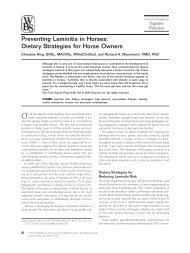Nutritional Secondary Hyperparathyroidism in the Horse
Nutritional Secondary Hyperparathyroidism in the Horse
Nutritional Secondary Hyperparathyroidism in the Horse
Create successful ePaper yourself
Turn your PDF publications into a flip-book with our unique Google optimized e-Paper software.
Serum Phosphorus, Calcium, and Alkal<strong>in</strong>e Phosphatase 77<br />
<strong>the</strong> surround<strong>in</strong>g fundamental substance an entity: “If <strong>the</strong> former dies,<br />
<strong>the</strong> latter is dest<strong>in</strong>ed to be resorbed. It is one of <strong>the</strong> pr<strong>in</strong>cipal laws of<br />
bone tissue.” RUTISHAUSER and MAJNO dist<strong>in</strong>guished two types of<br />
osteocyte necrosis, viz., rapid necrosis and slow necrosis or oncosis.<br />
“Rapid necrosis apparentIy occurs <strong>in</strong> osteocytes which have been<br />
directly affected by traumatism, and evolves <strong>in</strong> approximately six<br />
hours.” The lacuna is not enlarged and presents clear-cut borders. In<br />
oncosis, on <strong>the</strong> o<strong>the</strong>r hand, <strong>the</strong> duration of <strong>the</strong> process is from 24 to<br />
36 hours. The osteocyte undergoes swell<strong>in</strong>g, its nucleus may divide,<br />
and <strong>the</strong> lacuna is enlarged and appears rounded. Enlargement of <strong>the</strong><br />
canaliculi causes <strong>the</strong> lacuna to be <strong>in</strong>dist<strong>in</strong>ctly outl<strong>in</strong>ed. The alkal<strong>in</strong>e<br />
phosphatase of <strong>the</strong> bone cells varies considerably [RUTISHAUSER and<br />
MAJNO (1951); MAJNO and ROUILLER (1951)l. The osteoblast gives a<br />
highly positive alkal<strong>in</strong>e phosphatase reaction. The young osteocyte<br />
conta<strong>in</strong>s <strong>the</strong> enzyme to some degree, but <strong>the</strong> adult osteocyte lacks it.<br />
In <strong>the</strong> osteocyte undergo<strong>in</strong>g oncosis <strong>the</strong> enzyme reappears and <strong>the</strong><br />
sta<strong>in</strong><strong>in</strong>g <strong>in</strong>tensity is comparable to that of <strong>the</strong> osteoblast. No enzyme<br />
activity is left <strong>in</strong> <strong>the</strong> empty lacuna after oncosis. RUTISHAUSER and<br />
MAJNO <strong>the</strong>refore concluded that oncosis is a vital phenomenon, caused<br />
by irritation of <strong>the</strong> osteocyte, which <strong>the</strong>n “progresses toward its<br />
disease and death”. They referred to this oncosis not only as a regressive<br />
change <strong>in</strong> <strong>the</strong> osteocyte but also as a special form of bone resorption,<br />
<strong>the</strong> pericytic osteo&sis.<br />
The studies on alkal<strong>in</strong>e phosphatase of <strong>the</strong> osteoclasts by MAJNO<br />
and ROUILLER (1951) added fur<strong>the</strong>r <strong>in</strong>formation on <strong>the</strong> role of this<br />
enzyme <strong>in</strong> resorption of bone. Osteoclasts <strong>in</strong> <strong>the</strong> “osteolytic phase”<br />
showed an <strong>in</strong>tense alkal<strong>in</strong>e phosphatase sta<strong>in</strong><strong>in</strong>g reaction and so did<br />
adjacent bone under resorption. In <strong>the</strong> “rest<strong>in</strong>g phase”, i. e., when<br />
osteoclasts were not actively erod<strong>in</strong>g bone but were located at some<br />
distance from <strong>the</strong> bone surface, <strong>the</strong> osteoclasts showed almost no<br />
alkal<strong>in</strong>e phosphatase sta<strong>in</strong> reaction. MAJNO and ROUILLER <strong>the</strong>n concluded<br />
that <strong>the</strong> alkal<strong>in</strong>e phosphatase is not on4 an en? yme of bone apposition<br />
but also of bone resorption.<br />
With <strong>the</strong> results of RUTISHAUSER and his associates at hand <strong>the</strong><br />
<strong>in</strong>terpretation of <strong>the</strong> serum alkal<strong>in</strong>e phosphatase curves and <strong>the</strong>ir<br />
<strong>in</strong>verse relation to those of <strong>the</strong> serum calcium <strong>in</strong> our NSH horses<br />
offers no difficulties. As <strong>the</strong> hypocalcemia progresses because of progress<strong>in</strong>g<br />
hyperphosphatemia, <strong>the</strong> demand for calcium removal from<br />
<strong>the</strong> skeleton becomes greater and greater. The <strong>in</strong>duced hyperparathyroidism<br />
causes bone resorption, and calcium is liberated to a<br />
Downloaded from<br />
vet.sagepub.com by guest on April 14, 2010



